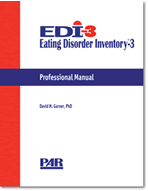The most widely used standardized self-report measure of symptoms and concerns characteristic of eating disorders.
Anonymous Feedback
Use the EAT-26 to help you determine if you need to speak to a mental health professional to get help for an eating disorder. It will take about 2 minutes to complete.
Take the EAT-40. The EAT-40 is the original version of the Eating Attitudes Test. The 40-item version was shortened to 26-items (EAT-26) based on a factor analysis.
The Eating Attitudes Test (EAT-26)
EAT-26 is probably the most widely used standardized self-report measure of symptoms and concerns characteristic of eating disorders. The EAT-26 is a refinement of the original EAT-40 that was first published in 1979 and used in one of the first studies to examine socio-cultural factors in the development and maintenance of eating disorders. Since that time, the test has been translated into many different languages and used in hundreds of studies. The original publication (Garner, D.M. & Garfinkel, P.E., 1979, Psychological Medicine, 9, 273-279.) and the subsequent publication describing the refinement of the test (Garner et al., 1982, Psychological Medicine, 12, 871-878) are the 3rd and 4th on the list of the 10 most cited articles in the history of the journal Psychological Medicine. This journal was founded more than 40 years ago. In a recent review of the 100 most cited articles in the eating disorder field (here), publications on the EAT were ranked #2 and #4 and the authors failed to include the most cited EAT-26 article (Garner, et al. 1982) that has been cited more than 6000 times according to Google Scholar. Thus, the Eating Attitudes Test has had a huge impact in the field of eating disorders. You can take the test today and download a copy for free on this website.
The EAT-26 can be used in a non-clinical as well as a clinical setting not specifically focused on eating disorders. It can be administered in group or individual settings and is designed to be administered by mental health professionals, school counselors, coaches, camp counselors, and others with interest in gathering information to determine if an individual should be referred to a specialist for evaluation for an eating disorder. It is ideally suited for school settings, athletic programs, fitness centers, infertility clinics, pediatric practices, general practice settings, and outpatient psychiatric departments. It is intended primarily for adolescents and adults.
The EAT-26 has been particularly useful a screening tool to assess “eating disorder risk” in high school, college, and other special risk samples such as athletes. Screening for eating disorders is based on the assumption that early identification can lead to earlier treatment, thereby reducing serious physical and psychological complications or even death. The EAT-26 should be used as the first step in a two-stage screening process. According to this methodology, individuals who score 20 or more on the test should be interviewed by a qualified professional to determine if they meet the diagnostic criteria for an eating disorder. If you have a low score on the EAT-26 (below 20), you still could have a serious eating problem, so do not let the results deter you from seeking help. For example, some individuals with Binge Eating Disorder (BED) score low on the EAT-26 but may have a serious eating disorder.
Completing the EAT-26 yields a “referral index” based on three criteria: 1) the total score based on the answers to the EAT-26 questions; 2) answers to the behavioral questions related to eating symptoms and weight loss, and 3) the individual’s body mass index (BMI) calculated from their height and weight. Generally, a referral is recommended if a respondent scores “positively” or meets the “cut off” scores or threshold on one or more criteria. Regardless of the score, if a respondent feels that they are suffering from feelings that are interfering with daily functioning, they should seek an evaluation from a trained mental health professional. The Eating Attitudes Test is not designed to make a diagnosis of an eating disorder or to take the place of a professional diagnosis or consultation. The EAT-26 alone does not yield a specific diagnosis of an eating disorder. Neither the EAT-26, nor any other screening instrument, has been established as highly efficient as the sole means for identifying eating disorders.
Permission to Reproduce: Go to the Permission Tab.
Other Questions?




